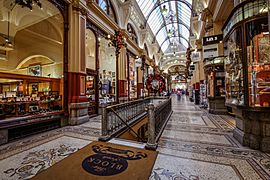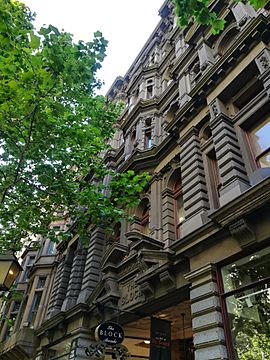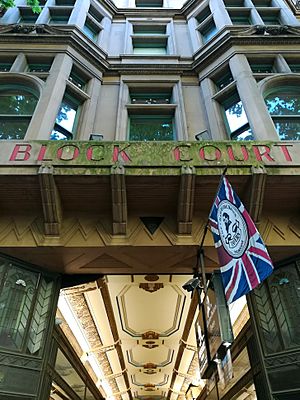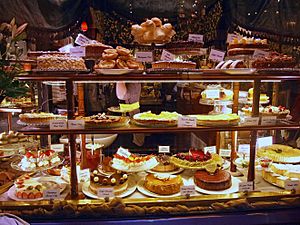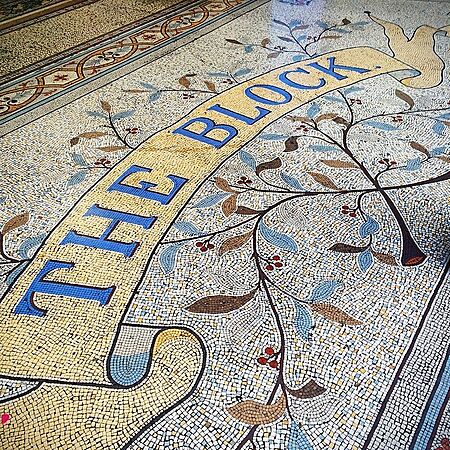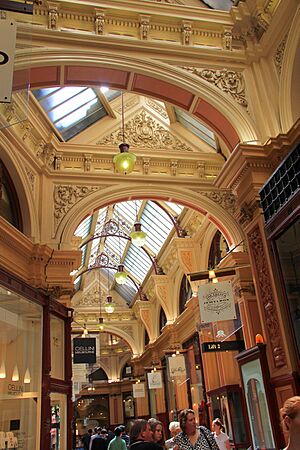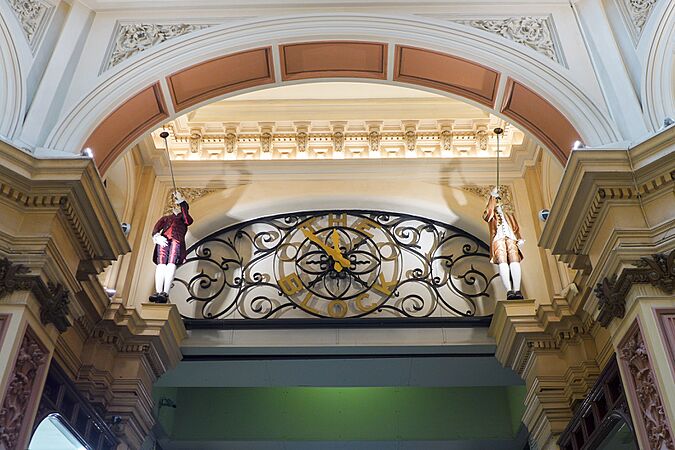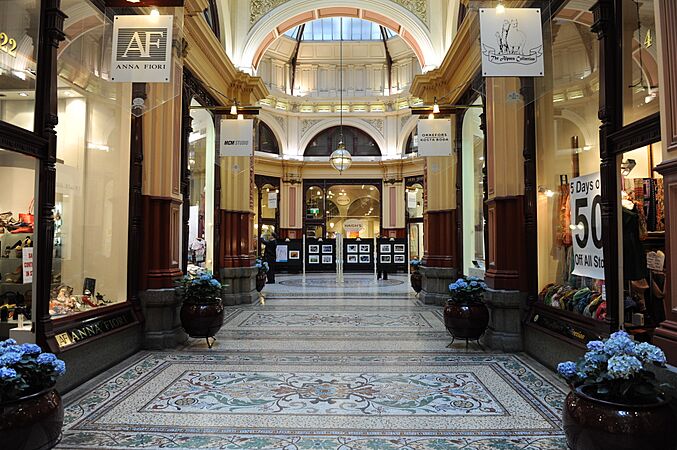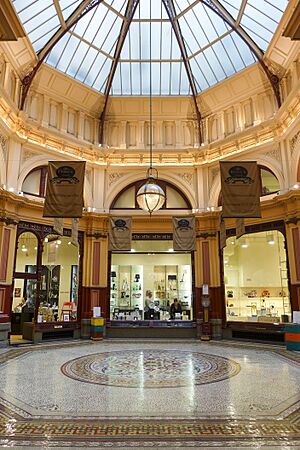Block Arcade, Melbourne facts for kids
|
From top: Block Arcade looking south, Collins Street façade
|
|
| Location | Melbourne, Victoria, Australia |
|---|---|
| Coordinates | 37°48′57″S 144°57′52″E / 37.81583°S 144.96444°E |
| Address | 282 Collins Street |
| Opening date | 1892 |
| Management | Allard Shelton PTY LTD |
| Owner | Block Arcade Melbourne Pty Ltd |
| No. of floors | 5 |
The Block Arcade is a famous old shopping arcade in the heart of Melbourne, Victoria, Australia. It was built between 1891 and 1893. Many people think it's one of the best shopping arcades from the late Victorian era. Today, it's one of Melbourne's most popular places to visit.
Architects Twentyman & Askew designed the Block Arcade. It has amazing decorations inside. You'll see beautiful mosaic tiled floors, a glass roof, fancy wrought iron, and carved stone details. The arcade is shaped like the letter 'L'. It has an eight-sided rotunda (a round room with a dome) in the corner. This connects Collins Street to Elizabeth Street. On the north side, the arcade links to Block Place. This is a covered walkway that goes to Little Collins Street. Right across the street is Melbourne's oldest shopping arcade, the Royal Arcade. The outside of the Block Arcade on Collins and Elizabeth streets is also very special. It shows some of Australia's best Victorian architecture in the Mannerist style.
The arcade got its name from a popular activity called "doing the block". This meant dressing up nicely and walking along a specific part of Collins Street. The Block Arcade is a protected building on the Victorian Heritage Register.
Contents
What "Doing the Block" Means
By the late 1870s, a part of Collins Street became very popular. This was the area between Swanston and Elizabeth streets. Wealthy people in Melbourne loved to walk there. They went to visit the fancy shops and cafes. It was also a place to see and be seen by others. This special walk became known as "doing the block".
A writer named Fergus Hume wrote about "doing the block" in his book The Mystery of a Hansom Cab. This book was first published in Melbourne in 1886. He described it like this:
It was Saturday morning and fashionable Melbourne was 'doing the block'. Collins Street is to the Southern city what Bond Street and the Row are to London, and the Boulevards to Paris... Carriages were bowling smoothly along, their occupants smiling and bowing as they recognized their friends on the side walk... Portly merchants, forgetting Flinders Lane and incoming ships, walked beside pretty daughters; and the representatives of swelldom were stalking along in their customary apparel of curly brimmed hats, high collars and immaculate suits. Altogether it was a pleasant and animated scene...
History of the Block Arcade
The Land Where it Stands
On June 1, 1837, the very first land sales happened in what is now Melbourne's city center. The land where the Collins Street part of the arcade now stands was bought by William Briscoe & Son. Their grain store was on this spot from 1856 to 1883. They even built a large new store there in 1877.
In 1883, the building was sold to the George brothers. They owned the George & George Federal Emporium. They had started their drapery (fabric and clothing) business a few doors away in 1880. They made changes to the inside of the building for their growing business. A rich businessman named Benjamin Fink was involved with the company. By 1888, he planned to move the store and build an L-shaped arcade in the area. He started buying up nearby properties.
Building the Arcade
On Friday, September 13, 1889, a huge fire destroyed the Georges Emporium. It caused over AU$400,000 worth of damage.
This fire happened during a time when Melbourne was growing very fast. Many big and fancy hotels, shops, and offices were being built. The fire allowed City Property & Co Pty Ltd, with Benjamin Fink as a main owner, to go ahead with their plans. They wanted to build a grand arcade on this important site. They hired architects Twentyman & Askew to design it in January 1890. The name 'The Block' was announced soon after. The part of the arcade on Collins Street was built first, finished by late 1891. The entire arcade officially opened on October 7, 1893.
The Collins Street part of the arcade has a slight bend. This is because the land gets narrower due to a small laneway on the west side. This laneway was originally called Carpenters Lane. The City Property Co asked to put a roof over it. This created a covered path from the Block Arcade to Little Collins Street. This led to shops opening in the laneway, which was then renamed Block Place. In 1902, the Royal Arcade, which used to be a dead end, was opened through to Little Collins Street. This created a covered walk all the way from Collins Street to Bourke Street.
People often say the design of the Block Arcade was inspired by the Galleria Vittorio in Milan, Italy. That arcade was built in the 1870s and also has a similar domed crossing, but it is much bigger.
New Owners Over Time
In 1986, the Time Corporation bought the arcade for AU$15 million. By 1991, Westpac bank took over the loan. In 1993, they sold the building to the Kearney family at a public auction. The Kearneys did a lot of work to fix up the arcade. They repaired the mosaic floors and repainted the inside in old-fashioned colors. They also fixed up the offices above the shops.
In 2014, the Cohen family bought the Block Arcade. The Cohen family has a long history with Melbourne, going back to the 1840s. Trevor Cohen's great-great-grandfather had one of the first leases in Melbourne. It was for the ground floor of 'Cashmore's Corner', near the Block Arcade. The Cohens really care about the arcade. They continue to keep it looking beautiful, paying close attention to every detail.
Block Court
Next to the Block Arcade, at 288-292 Collins Street, is a building called Block Court. It was built in 1890 as the Athenaeum Club. In 1930, the ground floor was turned into an arcade. This was designed by a famous architect named Harry Norris. It was one of Melbourne's first and most detailed Art Deco interiors. This arcade used to connect to the Block Arcade. One of the shopfronts in the Elizabeth Street part of the Block Arcade was removed to make this connection. At some point, the owners of the Block Arcade also bought this building.
In the 1990s, during the restoration of the Block Arcade, the shop was put back. The north end of the Block Court arcade was closed off. The shopfronts were removed to create a large shop area. In 2016, the Block Court Arcade was partly restored. The shopfronts were put back, but they became counters for a branch of the Bendigo Bank. You can still access a laneway through the back, which then leads into the Block Arcade.
Famous Shops in the Arcade
The Hopetoun Tea Rooms opened in 1894. A "society girl" named Miss Chrissie Robertson started them. They were designed to be very elegant for her wealthy friends. In 1907, the tea rooms moved to their current spot. In 1976, they were redecorated in a Victorian style. They had emerald and black wallpaper and velvet hangings on the ceiling. The Hopetoun Tea Rooms are sometimes confused with another tea room. That one was in the rotunda of the Ladies Work Association. This charity helped upper-class women who were having a hard time. It operated from 1891 to about 1900. Lady Hopetoun was a supporter of this charity.
The Singer Sewing Machine Company moved into a shop on the eastern side of the Collins Street entrance in 1902. They stayed there for many years. The shop was popular with women, and sewing classes were held in the basement. A scenic artist named Philip Goatcher was hired to paint a detailed mural on the ceiling. This mural is still there today.
The Block Arcade also had the first Kodak store in Melbourne. Kodak was a camera company from Rochester, New York. Kodak made it possible for everyday people to take photos. They helped make photography popular for everyone. The store sold camera parts, cameras, and equipment to both amateur and professional photographers. It also has a fancy pressed metal ceiling.
Images for kids


